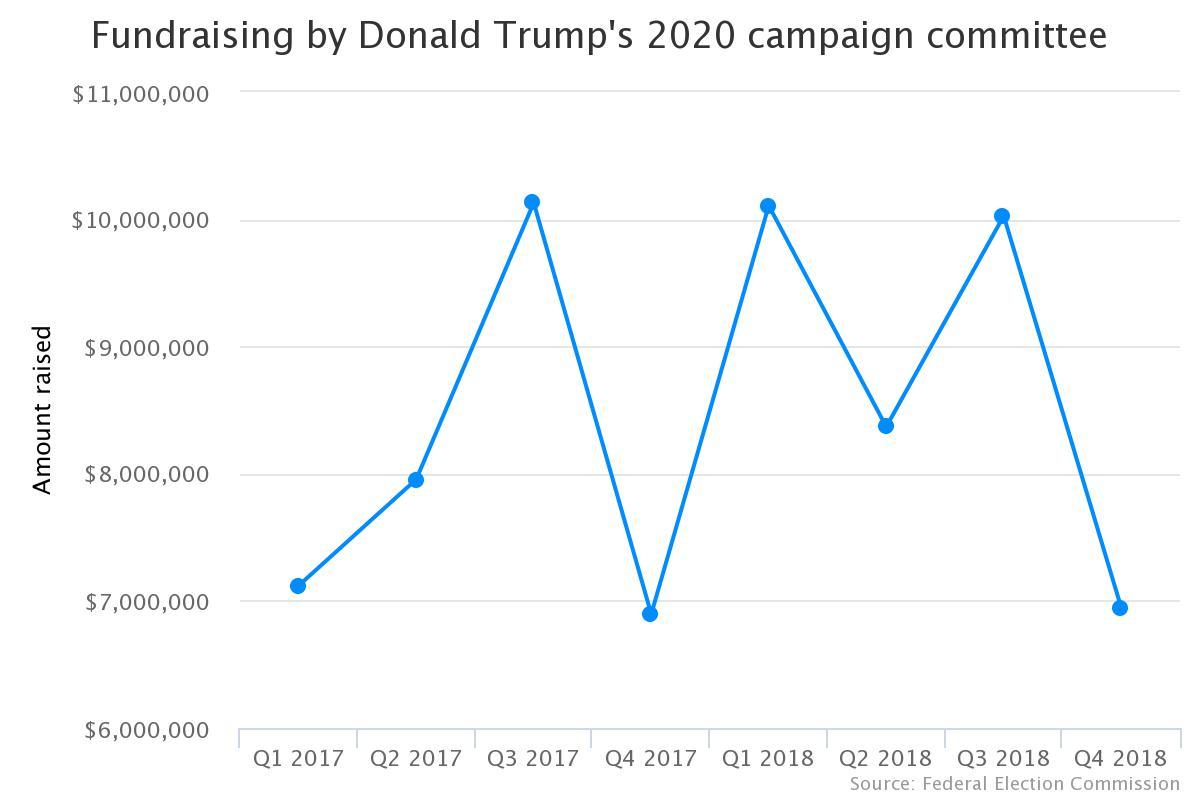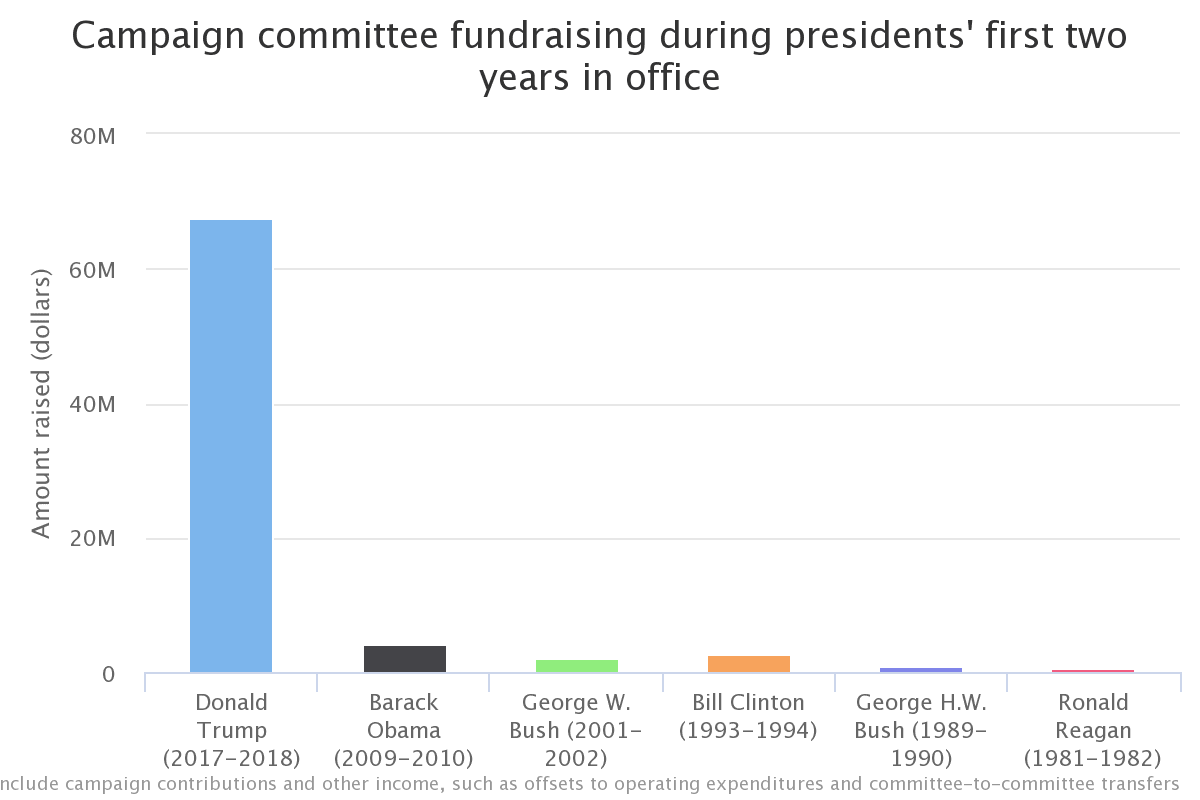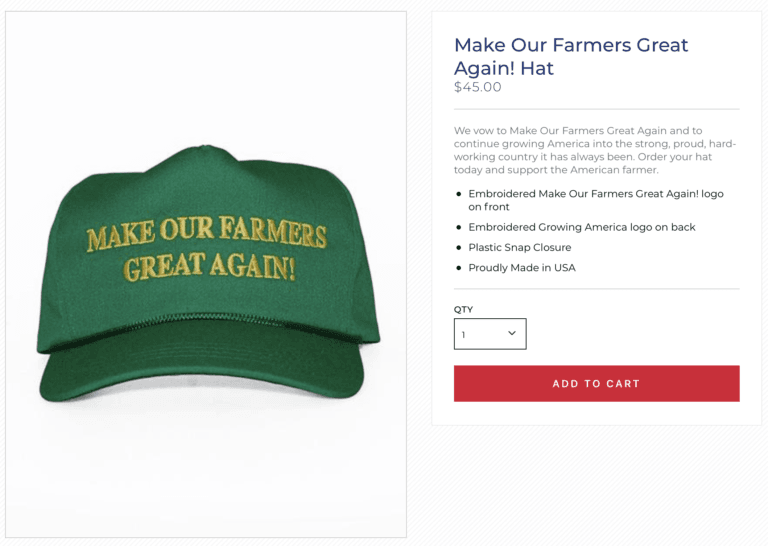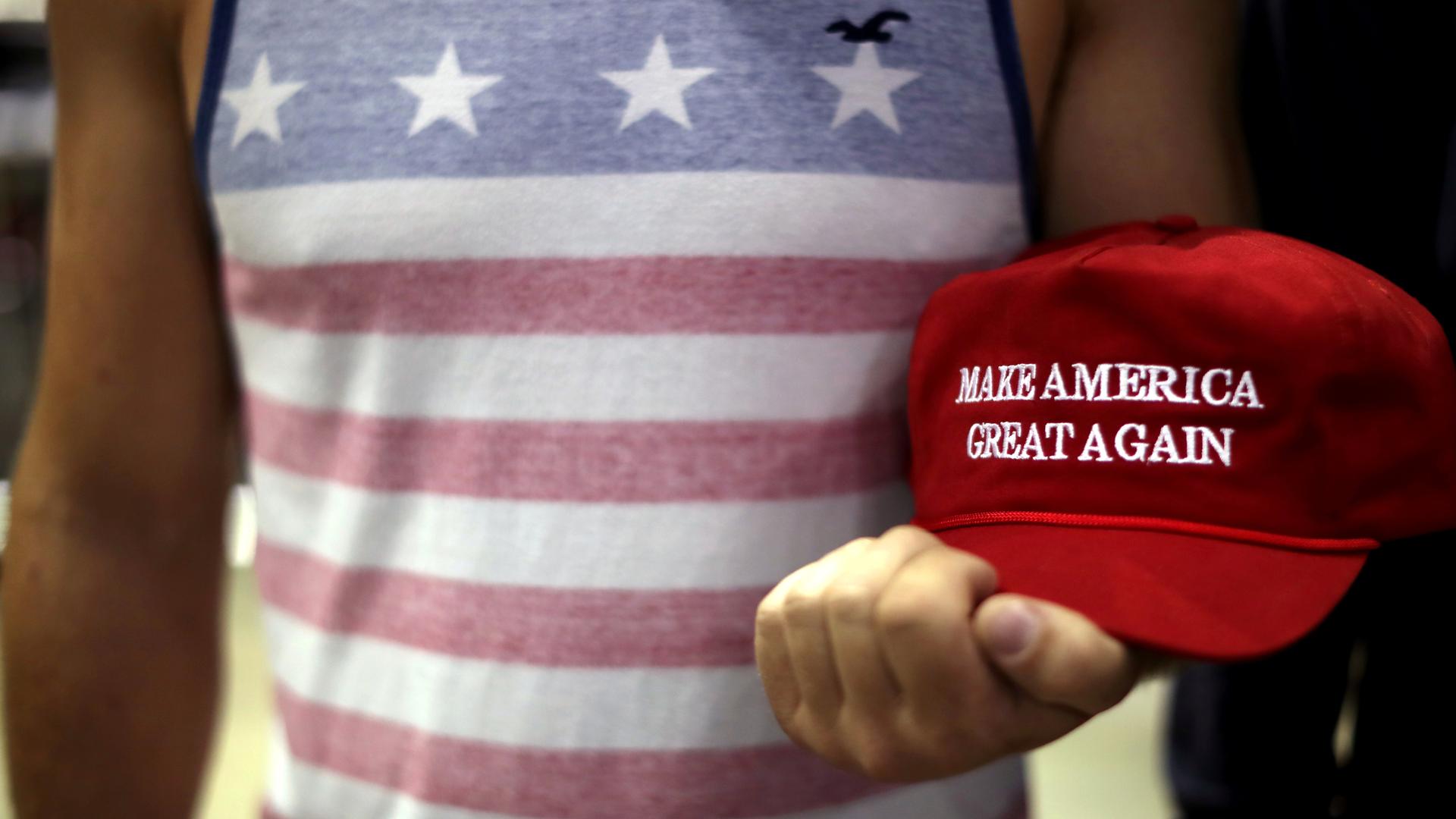Donald Trump created a permanent presidential campaign. Here’s how.
Supporters of US President Donald Trump attend a rally in Springfield, Missouri, USA, Sept. 21, 2018.
With a one-paragraph memorandum on the day of his inauguration, Donald Trump took action that would redefine how presidential elections are waged.
“[P]lease accept this letter as my Form 2 for the 2020 election,” Trump wrote the Federal Election Commission on Jan. 20, 2017.
What’s a “Form 2”? Bureaucratic parlance for a politician declaring one’s candidacy. And doing so allowed Trump to legally raise campaign money for an election nearly four years away.
Raise money Trump has. Unlike any president in US history. Starting the first day he took office — something no other president has done.
The result is a permanent presidential campaign in which the free world’s leader at times appears more occupied with running for re-election than running the country:
- Since his inauguration, Trump has conducted at least 57 political rallies — funded in part by his campaign and not official White House business. All but a half-dozen took place in states he won in 2016, allowing him to bolster his bases of support.
- During the 35-day partial federal government shutdown triggered by Trump’s desire to fund a wall on the southern border, Trump repeatedly solicited supporters with shutdown-themed fundraising messages. Come-ons included buying a “brick” for $20.20 to send to Speaker of the House Nancy Pelosi and contributing to an “Official Secure the Border Fund” — this wasn’t a government fund, but rather, Trump’s re-election committee. Trump’s website featured “Build the Wall” products when on Friday he declared a national emergency to secure wall funding, and his campaign texted supporters — “We have an INVASION!” — to send money.
- Trump has expertly and endlessly marketed his political brand, peddling Trump T-shirts and trinkets and MAGA swag, the proceeds from which go directly to Donald J. Trump for President. “They push those products so hard,” said Bentley Hensel, president of political e-commerce firm 1776 Consulting, who estimates 30 percent of the Trump campaign’s contributions during 2017 and 2018 could have come from merchandise sales.
- Trump has consolidated political power, moving to turn the Republican National Committee into a subsidiary of his own campaign committee by sharing office space, staff and fundraising operations — a move aimed at increasing efficiency and limiting internal squabbles. Numerous Trump allies, advisers and former staffers meanwhile help run a constellation of pro-Trump super PACs and nonprofits, which may raise and spend money without restraint. While these groups are nominally independent of Trump’s own campaign committee, Trump keeps some of them as close as he legally can, even attending fundraisers last year for the America First Action super PAC.
These efforts have added up.
Since the beginning of 2017, Trump’s own campaign committee has raised $67.5 million while seven major pro-Trump super PACs together have raised nearly $64 million more, according to a Center for Public Integrity analysis of federal campaign finance disclosures. Trump-aligned “social welfare” nonprofits have collectively generated additional tens of millions of dollars.

Related:Inside Donald Trump’s army of super PACs and MAGA nonprofits
And the Republican National Committee entered the 2020 presidential election cycle with $23.5 million in available funds, which Trump also stands to tap.
No other US president — Barack Obama, George W. Bush, Bill Clinton — marshaled any such operation two years into their respective first terms.

“President Trump has been a campaign finance innovator from Day 1. He’s really shattered all norms,” said Michael Toner, a former Republican Federal Election Commission chairman who’s now the election law and government ethics director at the Wiley Rein LLP law firm. “I don’t think we’ll ever again see a presidential candidate not raise money during the first two years of a first term anymore.”
But it wasn’t supposed to be like this.
Donald Trump himself said so.
“President Trump has been a campaign finance innovator from Day 1. He’s really shattered all norms. … I don’t think we’ll ever again see a presidential candidate not raise money during the first two years of a first term anymore.”
‘I don’t need anybody’s money’
After Trump descended a golden escalator and announced his first presidential run after decades of abortive attempts to win public office, he declared himself free of the forces that so often bankroll politicians’ aspirations.
“I don’t need anybody’s money. It’s nice. I don’t need anybody’s money. I’m using my own money. I’m not using the lobbyists. I’m not using donors. I don’t care. I’m really rich,” Trump said on June 16, 2015, during the same rambling speech in which he chided President Barack Obama for his golf habits and called Mexican immigrants “rapists.”
Other politicians “will never make America great again,” Trump continued. “They don’t even have a chance. They’re controlled fully — they’re controlled fully by the lobbyists, by the donors, and by the special interests, fully.”
And: “All Presidential candidates should immediately disavow their Super PACs. They’re not only breaking the spirit of the law but the law itself,” he tweeted in October 2015.
Perhaps Trump just lied.
Perhaps he yielded to the financial pressures of a presidential race in which a showdown with cash-flush Democrat Hillary Clinton loomed.
Either way, Trump’s early shtick — the super PAC bashing, the megadonor shaming, the “dark money” deriding — soon softened.
His generalized disdain for pay-to-play politics also faded as his campaign took off and his poll numbers soared. In mid-2016, Trump attended a pair of events for Make America Great Again PAC, a super PAC created to support his presidential bid. His presidential committee began aggressively soliciting contributions from anyone who’d give it money.
By the time Trump had all but captured the Republican presidential nomination, his reformist rhetoric had effectively ceased. Pro-Trump super PACs and the like, some run by close Trump allies, proliferated. (Today, more than a dozen such groups are actively trumpeting Trump.)
After Trump vanquished Clinton and won the presidency, he embraced a dubious and decidedly bipartisan presidential tradition, rewarding many of his top financial supporters with administration posts while courting the very special interests he once condemned to fund his presidential transition and inauguration.
Trump, like his predecessors, could have paused his quest for campaign money upon assuming the presidency.
Instead, he doubled, tripled, quadrupled down. Almost immediately.
“Our Campaign Committee, Donald J. Trump for President, Inc., is still here,” the Trump campaign wrote to supporters on Jan. 27, 2017, a week after Trump’s inauguration. “We will act as a beacon for our Movement of hard working patriots who delivered a historic victory this November.”
The message concluded with an invitation to visit Trump’s online campaign store, featuring an array of MAGA-themed merchandise, from wonted red “Make America Great Again” caps ($25) to the most Trump-tastic swimwear found from Pacific to Atlantic ($55).
By Feb. 11, 2017, the Trump Make America Great Again Committee — a joint federal fundraising committee composed of the Trump campaign and the Republican National Committee — began overtly asking supporters for money.
“We need to once again harness the same grassroots energy that led us to victory last year,” it wrote in an email. “Please contribute $100, $65, $50, $30, $25, or $10 to help us build a war chest to support President Trump as we face an onslaught of attacks from the far Left.”
“We need to once again harness the same grassroots energy that led us to victory last year. … Please contribute $100, $65, $50, $30, $25, or $10 to help us build a war chest to support President Trump as we face an onslaught of attacks from the far Left.”
Brand power
Trump supporters heeded these calls, which come almost daily in the form of emails, text messages, Instagram posts. The missives routinely use Trump bogeymen — liberals, journalists, the ongoing Mueller investigation into Russia’s involvement in the 2016 election — as bait.
Trump’s 2020 re-election committee raised more than $7.1 million during the first three months of 2017, according to FEC records. It raised nearly $8 million during the three months following. In the three months after that, it raised $10.1 million more.
The Trump campaign’s merchandising efforts are particularly effective because they make political donors out of people who may support Trump and his policies, but wouldn’t think of making a $10 campaign contribution, said Hensel of 1776 Consulting. Hensel’s company doesn’t count Trump’s campaign as a client but has supplied merchandise to pro-Trump super PAC Great America PAC.
While other major presidential campaigns, such as Clinton’s 2016 effort, have featured a bevy of promotional products, Trump has done with his political committee what he does as a businessman — market the Trump brand incessantly in attempts to turn a significant profit.

Hensel estimated that a single John Deere-inspired, yellow-on-green “Make Our Farmers Great Again!” hat, which today sells for $45 on Trump’s campaign website, nets the Trump campaign $25 to $30 per sale.
“Brad Parscale is a marketing genius,” Hensel said of Trump’s campaign manager. “They really listen to what the people on the ground want and are saying. They’re attracting a different kind of donor.”
The campaign spent the majority of what it raised during this time on the standard trappings of a major re-election campaign: rent, travel, salaries, consultants, insurance, media production, office supplies and — think red “Make America Great Again” hats — promotional items.
But Trump has also used his unprecedented flow of early campaign cash to cover millions of dollars in legal bills prompted in part by multiple investigations, including the investigation by Special Counsel Robert Mueller into Russian infiltration of the 2016 election. Federal law permits such spending.
Heading into 2019, the Trump campaign reported having $19.3 million in reserve. No US president has ever had so much available campaign money two years into his first term. Federal records indicate that all the US presidents together since Richard Nixon didn’t have as much campaign money through their two-year marks in office as Trump did.
This, coupled with the support Trump enjoys from super PACs and the Republican National Committee, gives him a major financial and organizational head start over his current and potential Democratic rivals. None of them have been actively campaigning for the presidency until this year and, individually, they have far fewer resources than Trump. (Trump personally gave his 2016 effort more than $66 million and, because he’s a billionaire, could also pour any of his own riches into his 2020 campaign.)
For example, among declared and likely Democratic presidential candidates, Sen. Bernie Sanders, I-Vt., leads all comers with $9.1 million from his Senate campaign committee and $4.7 million from his 2016 presidential campaign committee. Sen. Elizabeth Warren, D-Mass., has $11.1 million in her US Senate account while Sen. Kirsten Gillibrand, D-NY, has $10.3 million. Others have six or seven figures. Politicians may use money raised for US Senate or US House campaigns toward a presidential campaign.
Meanwhile, numerous pro-Trump super PACs and nonprofit organizations have continually buttressed the president personally — lambasting the media and the Mueller investigation, for example — while amplifying his positions on immigration, trade, national security and the economy.
The seven major pro-Trump political committees that raised a combined $64 million during 2017 and 2018 have spent large chunks of their wealth on ads and other Trump-boosting communications, FEC records indicate.
Two supportive nonprofits collected another $25.6 million during 2017, the latest data available, while a third brought in $46.4 million from April 1, 2016 to March 31, 2017, according to filings with the Internal Revenue Service.
The Republican National Committee has itself raised tens of millions of dollars more through joint fundraising committees, such as the Trump Make America Great Again Committee, which operates in conjunction with Trump’s campaign committee.
White House and Trump campaign officials did not respond to the Center for Public Integrity’s requests for comment.
But on Jan. 31, upon announcing the Trump campaign had raised about $7 million during the final three months of 2018, Trump campaign Chief Operating Officer Michael Glassner praised the campaign’s “grassroots support” that “remained both steady and historic.” It’s “a true testament to President Trump’s fulfillment of his promises made to the forgotten men and women of America,” Glassner said.
“When a president has started a formal campaign at the inception of the term, it is difficult for the president to appear ‘statesmanlike,’ but instead is always partisan and campaigning. … Also, the fact that money is being funneled to a campaign so early in the term implies to the public that there is an appearance of quid pro quo rather than governing.”
This perma-presidential campaign has consequences, said Ann Ravel, a former Federal Election Commission chairwoman who resigned shortly after Trump’s inauguration. Ravel, a Democrat, is planning to run for state Senate in California.
“When a president has started a formal campaign at the inception of the term, it is difficult for the president to appear ‘statesmanlike,’ but instead is always partisan and campaigning,” Ravel said. “Also, the fact that money is being funneled to a campaign so early in the term implies to the public that there is an appearance of quid pro quo rather than governing.”
So why wouldn’t Trump, who won the 2016 election despite Clinton’s campaign operation outspending him, dial his campaign efforts back and focus more on his duties as president?
“If Trump sees a dollar to be had, he chases it. This is a president who’s drawn to money,” said former Rep. David Jolly, R-Fla., who has often criticized Trump’s actions. “And for [a president], it’s a distraction from the job they’ve been hired to do.”
Are presidential campaigns too long?
Here’s one thing on which most Americans of all political leanings agree: An endless presidential campaign season is unbearable.
Two-thirds of Americans would like presidential campaigns to occur in a limited time frame, versus 14 percent who prefer no limits on how long such campaigns last, according to a Center for Public Integrity/Ipsos poll conducted in late January. This sentiment is shared almost equally by Republicans, Democrats and independents.
Two-thirds of Center for Public Integrity/Ipsos poll respondents also believe elected officials should be prohibited from raising campaign money during non-election years, with Democrats (72 percent) favoring such a restriction slightly more than independents (65 percent) and Republicans (63 percent).
Election fatigue is real.
Election fatigue is real, Ipsos pollster Chris Jackson said.
“Most Americans do not spend a lot of time thinking about politics, nor do they hold politicians in particularly high esteem,” Jackson said. “Put that together and you have many Americans being pushed into thinking about people they do not particularly like on a topic they do not particularly care about.”
Nevertheless, the US system of government lends itself to longer campaigns.
In most other countries — think the United Kingdom, or Canada — “candidates have less time to run for office and play less of a role,” said Nathaniel Persily, a Stanford University law professor and co-author of a recent Bipartisan Policy Center report, “Campaign Finance in the United States: Assessing an Era of Fundamental Change.”
Would federal lawmakers attempt to limit presidential and congressional campaigning, crunching electioneering into some defined period before Election Day?
Unlikely, several election law attorneys explain.
The reasons range from practical — politicians don’t like to put new limits on themselves — to fundamental: the First Amendment to the US Constitution. And modern courts have generally affirmed the rights of political actors — through decisions such as Citizens United v. FEC — to spend money on politics with few restraints.
Democrats, who control the US House, are pushing a massive government ethics reform package called H.R. 1, which includes numerous campaign and election provisions that could affect the ways campaigns are waged. But Republicans — who control the US Senate — have offered little support.
‘Anything but a normal election’
New Democratic candidates are entering their party’s intramural presidential fray by the week — there could be upward of 20 candidates running against one another by spring.
Trump, for now, has no serious competition, either for his party’s nomination or conservative campaign dollars, although a few Republicans, such as 2016 Libertarian vice presidential candidate Bill Weld and 2016 Republican presidential candidate and former Ohio Gov. John Kasich, are flirting with a 2020 run. Trump is free to continue operating in general election mode, even if he must stand for what may be little more than perfunctory primary votes.
Almost a full year remains before voters in Iowa and New Hampshire, which host the nation’s first presidential caucus and primary, respectively, cast their ballots.
Trump likely will continue to use his monopoly on the Republican side of the presidential race to conduct large-scale re-election campaign rallies, as he’s done from the earliest days of his presidency. His latest one came last week, when he visited El Paso, Texas, to talk about border security and building “the wall,” but also to sell Trump merchandise, bulk up his social media followings and otherwise fire up his core supporters.
Trump’s gaggle of supportive super PACs and nonprofits will continue their work all the while, peppering TV screens, social media feeds and inboxes with incessant pro-Trump messaging and fundraising appeals.
“This is anything but a normal election cycle.”
Respect is due to Trump for building such a formidable campaign operation, from his Twitter omnipresence to out-of-the-gate campaigning, said Adam Parkhomenko, founder of the Ready for Hillary super PAC, which formed nearly 2 ½ years ahead of Clinton formally announcing her 2016 presidential bid. Ready for Hillary raised millions of dollars to boost Clinton in anticipation she’d run and helped begin a trend toward super PACs serving as presidential campaign precursors.
Parkhomenko isn’t yet supporting any Democratic candidate after his preferred choice, attorney Michael Avenatti, declined to run. But all of the Democratic candidates better learn from Trump’s example as they attempt to defeat the president, Parkhomenko said.
“This is anything but a normal election cycle,” he said.
A clear indication of that: Howard Schultz, the billionaire who used to run Starbucks, is mulling running against Trump as an independent. And billionaire Michael Bloomberg may also run for president as a Democrat. In a bid to blunt Trump’s financial advantage and defeat him, Bloomberg is reportedly willing to invest at least $500 million in Election 2020 — even if Bloomberg doesn’t run.
That’s on top of the hundreds of millions more Democratic super PACs and political committees hope to raise toward the 2020 presidential race now that the 2018 midterms, which had been their almost singular focus leading up to November, are behind them.
Ashley Balcerzak contributed to this report.
The Center for Public Integrity is a nonprofit investigative news organization in Washington, DC.
Our coverage reaches millions each week, but only a small fraction of listeners contribute to sustain our program. We still need 224 more people to donate $100 or $10/monthly to unlock our $67,000 match. Will you help us get there today?
